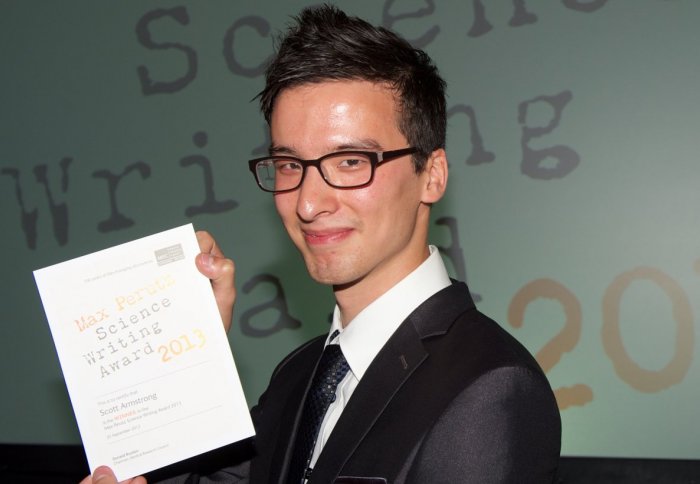Saving the brain from itself

Doctoral student Scott Armstrong's winning entry in the Medical Research Council's Max Perutz Science Writing Award 2013.
Close your eyes and picture a high-speed car crash. An elderly relative taking a tumble down the stairs. Muhammad Ali flooring Sonny Liston, or just another late night punch-up on the streets of Soho. The common feature here is a traumatic injury to the head, resulting ultimately in damage to the brain. Such incidents are collected together under the medical definition of ‘traumatic brain injury’ – a silent epidemic responsible for close to a million visits to A&E each year, and the leading cause of death and disability in under 45’s in the developed world. An epidemic which represents a major unmet clinical need, given that there are currently no drugs available to arrest the injury processes particular to this type of brain damage.
The fascinating thing about the sort of brain damage observed in a traumatic injury is that the damage caused by the initial, physical blow to the head comprises a relatively small proportion of the total damage the brain will eventually suffer. What actually happens is that in the minutes, hours, and even days following that blow, damage spreads across and into the brain, as a rot spreads through an apple. It is this damage that occurs after the physical insult that is responsible for the major burden of injury and the majority of deaths associated with brain trauma – reflected in the fact that a large percentage of trauma deaths occur weeks after the event.
The significant point here is that if the majority of brain damage occurs after the blow to the head, then there is scope for medical science to intervene: to attempt to lessen or even halt the spread of damage. Within my research group, we try to do just that; first by understanding the biological mechanisms underlying the spreading damage, and then investigating a novel drug treatment that we believe can slow it down.
The reasons underlying secondary, spreading brain damage are many and complex, but one particularly important component of the spread is a damaging biochemical cascade initiated in the brain as a result of the physical blow. In the normal scenario our brains cells communicate by throwing chemical messengers at each other across a miniscule junction; one brain cell will throw the messenger and another will receive it in a sort of catcher’s mitt specific to that chemical, called a receptor. Activation of the receptor by the messenger triggers a change in the internal biochemistry of the receiving brain cell, and the signal is carried onward. This goes on all the time and is perfectly normal. However, in the case of traumatic injury, brain cells near the site of the physical blow are torn open, allowing those messengers to flood out and go where they please.
The net result is an overloading of the receptors on neighbouring brain cells, which then become biochemically confused and begin to die from the inside out: brain cells killing themselves, essentially. Once dead, these cells will spill out their own chemical messengers in turn, kindling a damaging cascade that just keeps rolling – a rot spreading injury through the brain.
The drug we believe capable of stopping this secondary damage is a naturally occurring gas called xenon – a member of the family of noble gases, known by every GCSE chemistry student to be chemically inert. Much less well known is that once inside your body, xenon is biologically active: breathe it in and this supposedly un-reactive gas is both anaesthetic and analgesic – will both put you to sleep and prevent you from feeling pain. Xenon has these effects by blocking the activation of a particular cell receptor called the NMDA receptor, the very same receptor that is so crucially involved in the spreading damage after a traumatic injury.
We believe that by blocking the overloading of these receptors that occurs after a traumatic injury, xenon is able to prevent the biochemical confusion of brain cells and thus prevent them from proceeding along the pathway to cell death – is able to save the brain cells from killing themselves. It was in fact this serendipitous story of a chemical element practically defined by its inability to undergo chemical reactions having such a profound biological effect that first drew me to research in traumatic brain injury.
The World Health Organisation predicts that brain trauma will surpass many other diseases as the major cause of death and disability by the year 2020, largely as a result of car ownership in developing nations. Despite this, the condition remains relatively unknown in the public consciousness, and with no drugs yet available to arrest the spreading secondary injury particular to this kind of brain damage, research in the field of traumatic brain injury – saving the brain from itself – has never mattered more.
Scott's article was originally published on the MRC blog.
Article supporters
Article text (excluding photos or graphics) © Imperial College London.
Photos and graphics subject to third party copyright used with permission or © Imperial College London.
Reporter
Press Office
Communications and Public Affairs
- Email: press.office@imperial.ac.uk
